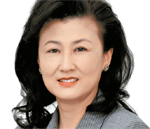Future competitiveness requires transformation

Shirley Yu Tsui, CEO of IBM Korea
Why are such global enterprises making efforts to transform themselves? In short, customers and the market are at the center of their efforts. In fact, only those that can provide value to markets and customers will survive in a fiercely competitive world. And this is why Korean enterprises should prepare for the transformation required to remain relevant and competitive.
For those who seek global competitiveness and new growth engines, it is worth looking back on IBM’s journey. In the early 1990s, IBM faced a survival crisis when it missed a shift in the market. However, IBM made a historic turnaround thanks to an audacious business model transformation.
“I am not an IT expert, but I know what IBM customers expect from us, as I was a customer of IBM,” said Louis V. Gerstner, the first IBM CEO hired from outside the company. “And it is an integrated IBM that can provide the high values that customers want.”
IBM began to transform itself from a product-based company into a market-driven one that can provide integrated “high value” solutions. As a result, IBM’s annual revenues grew by more than $20 billion from 1993-2001. IBM is now focused on providing high value to its customers in cognitive computing, the third era of computing systems, as well as Big Data and analytics, the cloud, and mobile and social business.
What should Korean companies do to transform themselves?
First, they should transform their business models based on the needs of customers. In the early 1980s, for example, Intel made a bold decision to give up memory chips, the core of its business at the time, due to fierce competition in the market, and turned to microprocessors. As a result, it achieved unprecedented growth. It is now making another turn in this mobile era by rapidly releasing a quark processor that can be attached to tablets and smartphones.
Second, an enterprise-wide rearrangement of resources is necessary. At the time of transformation, a company needs to reallocate top talent to units that lead new-growth engines. IBM, too, has continuously moved its core talent from advanced markets to growth markets and from base technologies to next-generation technologies. Recently, IBM redeployed more talent to next-generation technologies such as cognitive computing, the cloud, Big Data ,mobile, social business and security, and has continuously announced new solutions in those areas.
Finally, they should nurture a corporate culture that embraces innovation and allows mistakes. Thomas J. Watson, Jr., IBM’s second CEO, said, “We believe that every business needs wild ducks.” That is, we need to welcome new ideas and support those who think differently. Companies must be able to embrace diversity and be open to failure if they want innovation and transformation. 3M, one of the most innovative companies, encourages employees who failed, saying their failures may be used in the future. It adopts what they call the 15 percent rule for all technical researchers, which means they can spend 15 percent of their working time on their own personal projects. Its most famous products, Post-it and Scotchgard, were recreated from failures into innovations through the 15 percent.
Korean companies have a number of strengths and merits that can help create new opportunities and outpace global leaders. Advanced infrastructure, new technologies, the world’s leading Internet environment and mobile capabilities are among their greatest strengths.
Moreover, technological convergence across industries and pursuit of creativity add up. There are huge opportunities out there for those companies that want to stand out as global leaders, if they are dare to transform in ways their markets and customers want.
The world’s 50 most innovative companies in 2013, released by the Boston Consulting Group (BCG), last September listed Samsung Electronics in second place and Hyundai Motor Group 17th. As more Korean companies transform themselves into innovative enterprises, I expect to see more Korean names on the list in the near future.










with the Korea JoongAng Daily
To write comments, please log in to one of the accounts.
Standards Board Policy (0/250자)